Lifestyle was also according to the seasons of
the year, winter being the least busy. Men went to the woods to cut the trees from a pre-bought parcel, which could
be far remote from the farm. Since we did not have motorized vehicles, it was an all day affair, bringing our lunch
with us which we would reheat over a fire of underbrush.
The work could also consist of cutting off edge-rows bordering the fields of our farm.
Indeed, all the paths, to the fields and meadows were bordered by edge-rows that had to be cut every fifteen years,
providing most of the firewood for the year… There was neither fuel nor butane available then!
The women stayed at home, doing all the housework and other farm chores.
In the evening, we sometimes had a gathering: the men and kids played cards (tarot), the women knitted and gabbed.
There was great excitement when we had guests, and our gathering usually ended with a snack before parting company.
When we were guests in a distant hamlet, we went on a horse-drawn carriage, and when travelling at night it was
a very exciting expedition!
In the spring,
it was the start of the agricultural work: soil tilling and the seeding of oat, barley, corn, beets, and potato
planting. Gardening, spading included, was done by Mom and Mary. Beside vegetables, they had their heart set on
planting flowers. When the kinfolk came for a visit, the guests always asked to go look at the garden and congratulated
the hostess. Likewise, men went for a tour of the domain, dispensing many flattering comments.
It was during the spring of the year 1935 that our Grand parents Comparet celebrated
their golden wedding anniversary. We were all present, of course. Considering that they had 13 children, and had
large families of their own, one can imagine that this reunion was awesome! There were many songs and cheeriness
that day, at the Meurienne hamlet!
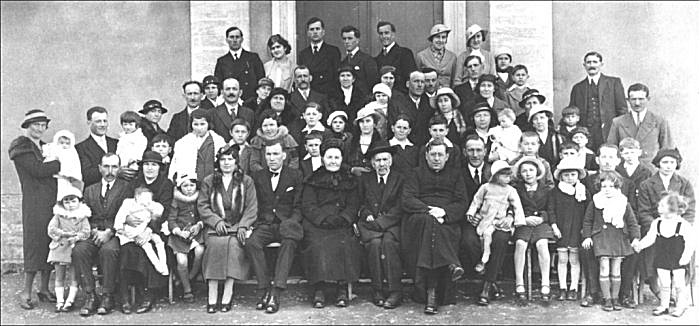 |
Golden Weeding Anniversary
of our Grandparents
Spring 1935 |
Summer time
was the season of hard work. All the plants had to be weeded, and cultivated one or twice by hands. Only the cutting
down of the hay fields, plowing, harrowing and harvesting was done with a horse. In the forties, because of extra
manpower available at our farm, we tried to use a second team. Consequently, we had to "train" two milk-cows
and use them as oxen: it was not an ideal solution, these cows being too frail for this type of work. This also
resulted in their yield of milk diminishing! That team of cows pulling the harrow required a kid in front to guide
it with reins on the shoulder. I proudly assumed this task, feeling as an adult!
The only mechanical device we used was the reaper pulled with a horse. The
modernization of the agricultural equipment would be very slow, and would truly start until the fifties. The hay
was cut down with the reaper, then turned over twice by hand with a pitchfork, and gathered up in bales. In the
evening, it was often piled up in stacks to preserve it against rain or dew. If the weather was favorable, after
two days, the hay could be loaded on the wagon. All the family contributed in this work:
An experienced young man was up on the wagon, receiving and stacking the hay bales that two other men handed to
him with pitchforks.
Women and kids, using rakes, collected the remnants. Another kid assumed the
"mission" to chase away the flies and other insects that annoyed the horse, with a flyswatter (a stick
with horsehair or a simple leafy branch).
What dishonor it was being in charge of piling up the hay on the wagon when
the load went unbalanced and undone because of ruts or rough terrain! The others derided him, of course! Instead,
how proud we were passing in front of the neighbors with a high and neatly balanced load, well combed and without
losing any hay!
The harvesting
of wheat, rye, oat and other mixed crops basically used the same method. After a preliminary reaping by hand around
the field perimeter, the horse-drawn mechanical reaper was used, going around the field, carefully following the
furrows so as not to damage the crop. Behind the reaper, the children on ties made from a handful of the cuttings
delicately repositioned the untied bundles. In the evening, after being tied the bundles would be erected in the
shape of a teepee to dry up. Later on, all the harvest would be stored in a barn or gathered in a big stack in
the middle of the courtyard.
When we harvested the last field, we had an
expression "let's capture the fox". This legendary custom was based on the belief that a fox had taken
refuge in this last field, in the last furrow and that it would be discovered and easily captured… However, I never
saw one single fox's tail!
The threshing,
in August: This was a great event in every farm. The threshing machine, owned by an entrepreneur, went from farm
to farm, driven by the boss himself with one or two assistant. The farmer would ask help from the other farmers
in the neighborhood, and each farm would send one helper. Therefore, a team of about 25 men would participate for
the work at hand. Threshing was really the most animated and convivial work.
It was very hard work, with a lot of dust and in the heat of the day. Nevertheless, the ambience was always very
enthusiastic. Early in the morning, everyone arrived with his pitchfork. We started the day with a cup of coffee;
then the farmer assigned everyone his task (everyone knew before hand what to do). There were those who fed the
threshing machine, bringing the bundles from the barn or the stack. One man, on the machine, untied the bundles,
and then two men carefully pushed them in the mechanism. Coming out of the machine, the straw was amassed into
an imposing bunch by the straw bearer who used a fork with two long prongs and carried it over the straw stack.
The bearer disappeared entirely under his load. The straw was received by two or three "old hands" that
had to make a perfect stack, able to resist against wind and rain. This straw stack was always well balanced and
reflected the farm's quality by its height and finish. Moreover, there were two strong men who had to bag the grains
and lift them up to the loft, with a heavy bag (220 lbs.) on their shoulders. Another man was responsible for cleaning
the husk.
Having enough manpower and several teams, allowed everyone to leave his position
to go have a drink, and to stretch on the grass in the shade for a few minutes.
In the morning, the mechanic who had already warmed up the vapor-boiler started
the threshing machine, and the sound of the engine could be heard in the entire neighborhood; a reminder to those
that were late to arrive for work.
After working two hours, around 9 A.M., we sat down at the table for breakfast.
If there was little to harvest, the threshing machine could service two farms
in one day. However for large harvesting, two days could sometimes be necessary. Every day ended with supper which
was very often the opportunity to have a party, without worrying about the hard work of the next day. Habitual
singers usually sang their favorite tunes without much coaxing.
Obviously, the farmer provided copious drinks, but if he was a penny-pincher, he would so much derided that he
had to provide food and drinks!
Women were always present in sufficient number and were very busy from morning
to evening; cooking, filling the glasses during the working hours, and serving at the table.
September
was the time for grape harvesting, because each farm had a few rows of vines producing wine with a low degree of
alcohol… a real rot-gut, but it was a satisfying and proud experience for everyone, as well as a source of savings.
In October,
it was the Autumn harvest time. Potatoes had to be pulled out of the ground with fork and collected by hand. Picking
the corn: the cobs were gathered in heaps, then carried on the wagon to the barn. In the evening they would be
partially husked, then tied in four cobs to be hung and dried under the awnings.
The malformed and smaller cobs were set aside to be toasted in the kiln, and
then the grain would be picked off. The grains once grounded would produce a fine and aromatic flour that was used
to make the "gaudes" (cornmeal-porridge).The corn silks would also be set aside by some of the young
ones to be sold later on, as well as some rabbit skins to make a few extra Francs.
Those evening gatherings to peel off the corn were most enjoyable and rejoicing
times for all. We were all gathered for a work that permitted to talk, and sing, without slumbering. However, a
kid would sometimes fall asleep on his seat, half enveloped in the corn residues. It was also a custom to help
the neighbors a few times in the Autumn, and likewise added to fellowship.Inevitably, at the end of the day we
all met in the common room for a little snack. This exchange of mutual help was automatic.
The last crops were the beets, which would be stored in basic silos, consisting
of piling up the beets in a pyramid, which was covered by straw, then soil. So the beets were protected against
frost. This technique was necessary since the farms of the Bressan region did not have basements.
In Autumn,
we also harvested sloes, which grew on the hedgerows. The crop was then put into barrels for fermentation, then
distilled with some other excess fruits, or fruits of average quality. Dad had his own personal alembic, but the
Germans in WW2 confiscated it to recycle the copper. In peacetime, and with the authorization from the administration,
Dad used to distillate a few liters of alcohol.
During the winter, the evening gatherings were also devoted to various tasks
such as wicker basketry, or using hazelnut tree rinds. Dad was very adept in this type of work and everyone would
use his method.
In these times, we also cultivated hemp, destined for the fabrication of big
ropes for the animals, and the lashing of the hay wagon. The hemp was then cut at maturity, dried, and then immersed
in the river. This procedure would permit the cleavage of the rind used for the braiding of ropes. -That was known
as the retting-
Corn shelling was done during the winter: either in the attic during daylight,
or in the common room in the evening. We had to take down the cobs that were being dried under the awnings, and
bring them in the common room. After supper, we scrapped the kernels off the cobs using a shovel blade set on a
seat, on which we sat astride. It was fastidious work, and we had to be careful to avoid hand injuries.
|
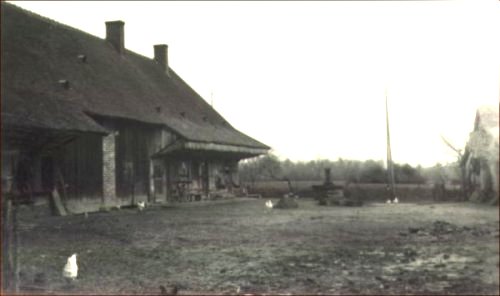
|
The farm courtyard in the forties.
We can see the corncobs hung under the awning. |
Another notable event in the winter was the traditional annual killing of a
pig, an event that was eagerly awaited.
The pig was taken from the farm of course, and we had to call on the services of the local "pig killer".
He was a picturesque personage to say the least …Canichou was his nickname. Cleanliness was not his forte, far
from it, but we had to resort to him. The ritual lasted all day: killing of the pig, grilling it on a straw fire
to depilate the thick skin, and scouring the skin basted with boiling water. Then, the pig was hung on some sort
of a ladder, where it was cleaved and eviscerated. The cutting out in pieces was done on the table in the common
room. A large portion of the cut pieces was salted in a large seasoning bowl and used to make delicious pâtés,
roasts, grilled foods and blood sausages. As for the "pig killer", his thirst had to be taken care of
copiously!
The next day, Mom would render the lard that we ate on slices of bread and
we also used it for cooking. Rendered lard also produced cracklings, which we ate without fear of cholesterol …
At our house, we did not make butter, we had to buy it and we rarely consumed it. The lard replaced butter!
Every week, Monday was a day of particular activity, with the market or fair.
All that we had to sell had to be taken to Louhans. The cattle were "walked" to the market, whereas veal,
pigs and poultry were brought in on the horse drawn wagon rigged with special cages. All the products we had to
sell required an admittance fee to the market. This market was also the occasion to buy our supplies for the weekly
need.
We walked to school for the entire duration of the school years. However, during
inclement weather in the winter, or when it rained heavily, our Dad would harness the mare to the wagon to bring
us to school.
Walking to school during periods of heavy rain would cause us not only to get
drenched, but having to sit in school all day with our soaked wooden-shoes. When the wagon took us to school, it
would be loaded with as many children as it could carry, and indeed it was a cheerful event for all of us. Of course,
we would have been prouder if we could have ridden in a real carriage like some people owned, but all we had at
our place an old, and unused relic…It sometimes happened, that our neighbor Pierre Paquelier whom owned an attractive
carriage would offer its use for exceptional religious events such as first communions.
|
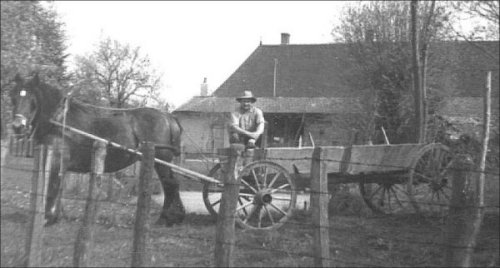
|
"The wagon", vehicle for the transporting of all wares; animals and persons.. |
The roads of our community were not paved, only
covered with gravel and traveled by very few automobiles. There were only a few trucks passing through for the
milk collection, and greengrocer and baker deliveries. Among them was our uncle Jean Comparet, greengrocer at La
Villeneuve who every week made his round and whom we happily expected. Today, I still remember his truck with oil
and vinegar jugs set on the sidestepping boards. All the products were sold in gross then, and all packaging were
preciously preserved.
During the World War Two period (from 1941 to 1945), we resumed making bread
at our house. We had to, because of the food rationing, and bakery bread was of very poor quality. We had an old
but still working oven, so we resumed this old custom (and chore) weekly. It was an important day for all of us
and a hard task for those who had to knead the bread dough (by hand, of course). For this occasion, Mom prepared
a few pies or brioches. For me who was boarder in a pension during this period, and who never had tasted such delicacies,
holiday times were blessed times.
During WWII, it was prohibited to own shotguns. By law, they had to be stored
in the town hall. As a result, poaching increased big time by the more daring hunters. One of my brothers paid
the price when he was caught, retrieving a hare captured with a noose. The affair ended at the tribunal with the
consequent penalties. The young poacher had real talents since he is now an efficient trapper of varmints in the
commune of Chateaurenaud hunting society.
The Seille River in the summer was a meeting place for the boys. It was a place
to take an occasional dip. The river water was of better quality and at a higher level than it is now. We even
had a rudimentary diving board installed.
Fishermen kept away from our swimming activities, which were not a favorable situation for catching fish.
We also went to the Seille River sometimes to do some laundry, or to steep the hemp.
|
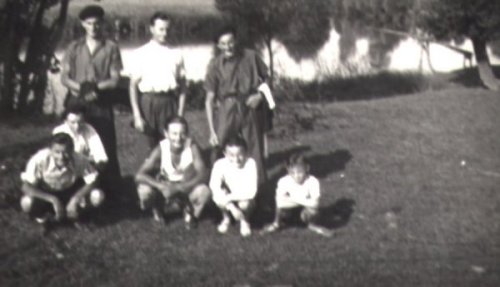
|
Bank of the Seille river, on a summer Sunday.
The diving board is on the right. |
Festivities , at the Paquelier's house, as in most country families were mainly religious (catholic) celebrations
in which we assiduously participated.
At Christmas, we went to midnight mass, on foot obviously. After mass, we came
back home and we ate a light and quick snack (hot chocolate with a piece of pie or a slice of brioche). We put
our wooden shoes under the chimney to discover the next morning a few sweets the next morning usually candies,
dates, oranges or tangerines. We never expected toys, but sometimes a family member better off financially would
give us a second-hand toy…
New Year's Day, we gladly went to the neighborhood to present our best wishes.
It was occasion for the men to have a drink of alcohol, or a cup of coffee. We never received gifts from our parents,
but our Godfather or Godmother often gave us one or two small coins.
During the times when our Grandmother was living with us at home, I am now told that she traditionally gave each
one of us a chocolate bar.
Easter preparation was preceded with the usual Lenten period, including praying
at the stations of the Cross every Friday. On Palm Sunday the children of well to do families brought palms garnished
with sweets, but never for us).
Corpus-Christi celebration consisted of a formal procession outside of the church, with flowers throwing.
In May or June, at the age of 11 and 12, the children had to celebrate their
first Eucharist (communion) after attending a retreat that lasted a few days. It was a great celebration. For this
occasion, we usually bought our first long pants suit. Sometimes the clothing merchant would add a watch as a bonus.
Godfather and Godmother traditionally offered a Missal and a Rosary. During this first communion mass, brioche
was served as blessed bread.
Pentecost was a Parish feast in Louhans but we did not participate. The Parish
festivities in Chateaurenaud were on August 11 (St Laurent's day). It was an opportunity for a family reunion,
as it was also customary on August 15, the feast of the Assumption of the Blessed Virgin Mary.
The First November was the day for visiting the family graves at the cemetery.
Baptisms were always celebrated on Sundays after the mass, and it ended with a race to pick up the sugar coated
almonds that Godfather and Godmother had scattered in front of the church.
Other memorable yearly events were the parade of "the conscripts"
(those ready to be drafted into the military). In January, young men 20 years of age assembled together and went
around the community for about a week before their legal military service. They visited all homes, with a flag
bearer in the lead, accompanied by one or two musicians (accordion, bugle or trumpet). They "passed the hat"
for their banquet at the end of their round. They somewhat lingered in the families having a girl, or the family
of one of them who had prepared their meal. On the last Sunday, they attended a special mass where brioche was
served instead of the usual blessed bread.
In our family we completely neglected the birthdays and the day of Christian
name celebrations, but maybe that was unusual.
The family gatherings (except for the rare golden wedding anniversaries) were attended by only two or three families
for Baptisms or First communion, which required the attendance of Godfather and Godmother. Outside of these celebrations,
for the event of the pig killing when we made blood sausage, we usually invited one of our related families.
At home, we never used nicknames in lieu of first names. But at school, other
kids used them to address us… Like some other local family names, ours was usually spoken in the local dialect,
just like our first names. Anyway, this dialect was always spoken in the country. Children started school when
they were 4 or 5 years old, most of them had never spoken French, only our local dialect. Even in the town, of
Louhans, the merchants had to speak our dialect; it was almost essential for them to do business.
At our house, the everyday way of life was very
different than it is today. Refrigerator, and washing machine were unknown of course. In the summer, the rare perishable
food staples (butter or cream) were brought down into the well, just above the water level, in a basket attached
to a rope. At the water level the temperature was always very cool during summer and winter. Usually however, we
used a small cellar that stayed relatively cool as a larder, including the seasoning bowl, the wine barrel, eggs
and cheeses.
Armoires were few but were enough to hang up the entire family's clothing.
Having a large family meant that the younger kids wore the clothes of the older siblings until totally worn out.
We had clothes for Sunday, clothes for school and we wore very old clothes around the house. As a rule, we only
changed once a week. Our shoes were clogs (two pairs). One pair was well worn out, and sometimes even pierced with
holes that we used only in the common room. The other pair was used for school. Wood shoes were shod with special
spikes, or rubber straps to extend their usage. Indeed, the roads were not paved; they were covered with pebbles,
and full of potholes
When it was icing in the winter, we enjoyed sliding on the ponds that were located on our way to school, as well
as in the farm ponds.
We also had a "Sunday" pair of shoes, and when we were able to afford
it, we could hope to get one pair of "fancy" high top leather shoes called "galoshes", which
had a wooden sole with leather upper.
During periods of heavy snow, our Dad would bridle the mare to a make chief snowplow that he had designed and built:
it consisted of two planks obtained from an old wagon, assembled in V shape and weighted down. He cleared the road
as far as the road portion that had been clean by our neighbors.
Usually, we did the laundry once a week. It
was my Mom and my Sister Mary's responsibility. They first boiled the dirty clothes in a large cauldron reserved
for this purpose, and then the clothes were scrubbed with a brush, either in a big tub equipped with a washboard,
or in one of the ponds that was nearby. Sometimes, when the ponds water level was too low, the laundry was done
in the Seille River located almost one mile away and we got there by horse and wagon. It was an opportunity for
us kids to dip a rudimentary fishing line to catch a "make believe" fish.
During the winter, we moved the stove in the middle of the common room to better
distribute the heat in this large room where the drafts ran from one door to the other. We also set up a stove
for the animals that provided additional heat, and produced an appetizing aroma from evening to morning since we
used "Swedish turnips" for fuel.
I recall a misadventure that occurred one day when the stove was located in
the middle of the common room. Paul and I were bickering, chasing each other around the table and at every turn
we held on to the column that supported the central beam as it permitted us to go round and round faster…until
this column gave in that is!
As luck would have it, the column fell on the stove causing important damages.
As a result, we were severely reprimanded along with a spanking, but we were too sheepish about our misdeed to
complain. Our very adept Dad was able to repair the stovetop, but the traces of our misdeed remained visible for
a long time afterwards.
Another small remembrance: On the central beam of the common room, there was
a small wooden support used to insert a stick of wicker into it. On occasions, this stick was used if necessary
to correct anyone of us kids. This stick was placed high enough to keep us from stealing it, or break it.
|
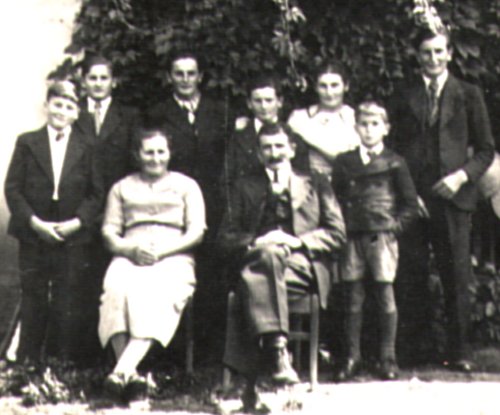
|
Our family:
Summer 1939. |
Life
at school. After this outline of our life in the familial cocoon, I would
like to evoke the years 1932 - 1939 at the primary school in Chateaurenaud. Except for the Kindergarten school,
which was mixed (boys-girls), we had two separate schools, one for the boys, and one for the girls. Every school
offered two level of education, the equivalent of American grammar school and junior high school.
From the first school years photos, we see four brothers attending the boy's
school: Jean, Francois, Paul, and myself. I believe that Marie and Pierre had already left school, after obtaining
their Primary Studies Certificate. At that time, I had long blond curly hair, that Dad would cut a while later,
in spite of Mom's despair. On this photo, I had long hair.
Recently we evoked the memories of one schoolmaster we had in 1935. He was
a young teacher, with a passion for motorcycle and aviation. I can still see him working on his motorcycle, under
the covered courtyard while we were eating a snack from our satchel. He only stayed at our school one year, and
then he joined the French Air Force as an Officer Pilot. He was shoot down in May 1940, …by French airplane anti-aircraft
fire of all things.
The memories about my years in the middle class are few. However, memories
of the years 1936-1939 while attending the upper class are more numerous. Mr. Marichy the school principal was
also an exceptional teacher, and even the most inept students have kept great respect for him. I think that he
had a soft spot for me... As I was somewhat lazy, I never did my homework and as punishment, I was retained at
school almost every evening, except during the winter when the teacher would not permit me to get back home alone
at night. He once confided to my parents that he enjoyed retaining me after school because I kept him company while
he corrected our workbooks.
As I lisped a little, he often mimicked me when he talked to me, or when he
talked about me to my parents. I obtained the Primary Studies Certificate without difficulties in June 1939, nearing
the normal 12 years of age.
|

|
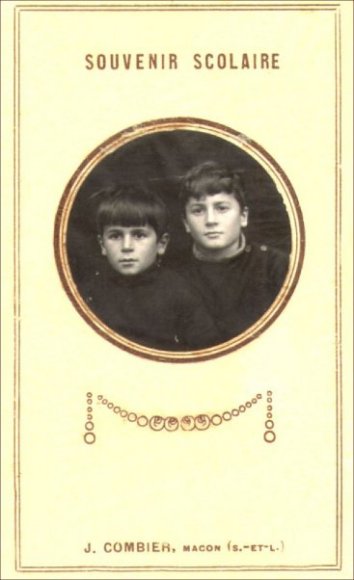
|
|
School year 1933/34:
My brothers Jean, Paul, François and I, sitting down.
|
School, year 1938/39:
Charles and I (right).
|
What follows are also a few memories regarding
a very important part of our family life; our religious education. As it was the case for most rural families of
this era, we were indoctrinated to religion at an early age. Our first exposure to the French language had been
through prayers, because we only spoke our local dialect within our families all over the region, except in school
and church.
At our house, the family usually recited the evening prayers together, except
in the summer when we omitted this ritual because of the late working hours, and with everyone being so tired.
Everyone kneeled on his seat, except the parents who leaned on it, in front of the crucifix and a statue of Our
Lady the virgin Mary that were over the mantel.
On Sunday, everyone attended mass. Some preferred the first early mass; it
was a low mass, hence shorter. But it happened that Paul and I were asked by our Priest (a friend of the family)
to be included in the group of the altar boys. It was an honor that no one could refuse. I remember that on some
Thursdays my Brother and I practiced the ritual of mass at our house in order to be proficient among our elders.
The bell was substituted with an empty box of shoe polish filled with gravel. We also had to know all the responses
in Latin without jabbering.
Consequently, there were no excuses for us
not attending Sunday Mass. We had to assist at the high Mass and at the afternoon Vespers. During the week, we
took turn to assist at the daily Mass before school. We also had the privilege to be excused from school for funerals.
I think that it was the reason that we got a bike; to go to and from at those services. Likewise, our Priest managed
the "kitty" supplied by the donations of the faithful to us on the occasion of funerals or baptisms.
Every New Year's day, the total donations were tallied and the amount was divided between us the ten or so altar
boys. The priest also added a handful of left over sugared almonds that he usually received at baptisms.
The usual ceremonies for every child were, the baptism which occurred about
fifteen days after birth, followed by the Holy solemn Communion at about 11 or 12 years of age after completing
the required catechism classes during the school years, and then the Sacrament of Confirmation the next year.
The children of school age also attended the "Patronage" (a Church
youth organization), usually on Sunday after Vespers. Some excursions were planed from time to time, mostly to
the nearby Jura mountains. Boys and girls had their own organization, (segregated of course), under the responsibility
of the Priest and a few adults. They had theatrical activities and also excursions. In the winter, the men had
a weekly evening, mainly spent playing cards. All those activities took place in the fellowship house, which much
later would become the Youth's Home.
Once, after a Church meeting where I had gone to by bicycle, I experienced
my first accident: Riding too fast and recklessly around the House, I ran into the Priest's car coming in the opposite
direction. The bike passed under the car and I was hurled aside on the grass. There was great disarray and apprehension
when the parson brought me back at our house in his car. But, all ended well, especially the insurance covering
the expenses for the reparation of the bike that was in pitiful condition.
It was in this ambience, and not by accident, that I was sent to secondary
school in a religious institution (… the boarding being free). My parents, encouraged by our Priest, would have
considered it a grace of God if one of their sons had become a Priest. Help was plentiful at the farm, so I could
have been excluded without any problem and prejudice, since I appeared to have the right disposition for studies
and other projects…!
This, will take us to the next chapter.
Adolescence - Secondary Studies - 1939 / 1944



